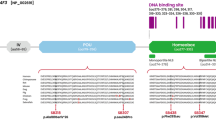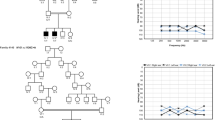Abstract
Progressive hearing loss is common in the human population, but little is known about the molecular basis. We report a new N-ethyl-N-nitrosurea (ENU)-induced mouse mutant, diminuendo, with a single base change in the seed region of Mirn96. Heterozygotes show progressive loss of hearing and hair cell anomalies, whereas homozygotes have no cochlear responses. Most microRNAs are believed to downregulate target genes by binding to specific sites on their mRNAs, so mutation of the seed should lead to target gene upregulation. Microarray analysis revealed 96 transcripts with significantly altered expression in homozygotes; notably, Slc26a5, Ocm, Gfi1, Ptprq and Pitpnm1 were downregulated. Hypergeometric P-value analysis showed that hundreds of genes were upregulated in mutants. Different genes, with target sites complementary to the mutant seed, were downregulated. This is the first microRNA found associated with deafness, and diminuendo represents a model for understanding and potentially moderating progressive hair cell degeneration in hearing loss more generally.
This is a preview of subscription content, access via your institution
Access options
Subscribe to this journal
Receive 12 print issues and online access
$209.00 per year
only $17.42 per issue
Buy this article
- Purchase on Springer Link
- Instant access to full article PDF
Prices may be subject to local taxes which are calculated during checkout




Similar content being viewed by others

Accession codes
References
Fortnum, H.M., Summerfield, A.Q., Marshall, D.H., Davis, A.C. & Bamford, J.M. Prevalence of permanent childhood hearing impairment in the United Kingdom and implications for universal neonatal hearing screening: questionnaire based ascertainment study. Br. Med. J. 323, 536–540 (2001).
Gates, G.A., Couropmitree, N.N. & Myers, R.H. Genetic associations in age-related hearing thresholds. Arch. Otolaryngol. Head Neck Surg. 125, 654–659 (1999).
Hrabe de Angelis, M. et al. Genome-wide, large-scale production of mutant mice by ENU mutagenesis. Nat. Genet. 25, 444–447 (2000).
Lewis, B.P., Burge, C.B. & Bartel, D.P. Conserved seed pairing, often flanked by adenosines, indicates that thousands of human genes are microRNA targets. Cell 120, 15–20 (2005).
Weston, M.D., Pierce, M.L., Rocha-Sanchez, S., Beisel, K.W. & Soukup, G.A. MicroRNA gene expression in the mouse inner ear. Brain Res. 1111, 95–104 (2006).
Duan, R., Pak, C. & Jin, P. Single nucleotide polymorphism associated with mature miR-125a alters the processing of pri-miRNA. Hum. Mol. Genet. 16, 1124–1131 (2007).
Enright, A.J. et al. MicroRNA targets in Drosophila. Genome Biol. 5, R1 (2003).
Shivdasani, R.A. MicroRNAs: regulators of gene expression and cell differentiation. Blood 108, 3646–3653 (2006).
Dallos, P. et al. Prestin-based outer hair cell motility is necessary for mammalian cochlear amplification. Neuron 58, 333–339 (2008).
Liberman, M.C. et al. Prestin is required for electromotility of the outer hair cell and for the cochlear amplifier. Nature 419, 300–304 (2002).
Sakaguchi, N., Henzl, M.T., Thalmann, I., Thalmann, R. & Schulte, B.A. Oncomodulin is expressed exclusively by outer hair cells in the organ of Corti. J. Histochem. Cytochem. 46, 29–39 (1998).
Goodyear, R.J. et al. A receptor-like inositol lipid phosphatase is required for the maturation of developing cochlear hair bundles. J. Neurosci. 23, 9208–9219 (2003).
Wallis, D. et al. The zinc finger transcription factor Gfi1, implicated in lymphomagenesis, is required for inner ear hair cell differentiation and survival. Development 130, 221–232 (2003).
Holme, R.H. & Steel, K.P. Stereocilia defects in waltzer (Cdh23), shaker1 (Myo7a) and double waltzer/shaker1 mutant mice. Hear. Res. 169, 13–23 (2002).
Rhodes, C.R. et al. A Myo7a mutation cosegregates with stereocilia defects and low-frequency hearing impairment. Mamm. Genome 15, 686–697 (2004).
Self, T. et al. Role of myosin VI in the differentiation of cochlear hair cells. Dev. Biol. 214, 331–341 (1999).
Kiernan, A.E. et al. The Notch ligand Jagged1 is required for inner ear sensory development. Proc. Natl. Acad. Sci. USA 98, 3873–3878 (2001).
Bock, G.R. & Steel, K.P. Inner ear pathology in the deafness mutant mouse. Acta Otolaryngol. (Stockh.) 96, 39–47 (1983).
Vreugde, S. et al. Beethoven, a mouse model for dominant, progressive hearing loss DFNA36. Nat. Genet. 30, 257–258 (2002).
Spiden, S.L. et al. The novel mouse mutation Oblivion inactivates the PMCA2 pump and causes progressive hearing loss. PLoS Genet. 4, e1000238 (2008).
Bosman, E.A., Quint, E., Fuchs, H., de Angelis, M.H. & Steel, K.P. Catweasel mice: a novel role for Six1 in sensory patch development and a model for Branchio-Oto-Renal syndrome. Dev. Biol. advance online publication, doi:10.1016/j.ydbio.2009.01.030 (2 February 2009).
Mburu, P. et al. Defects in whirlin, a PDZ domain molecule involved in stereocilia elongation, cause deafness in the whirler mouse and families with DFNB31. Nat. Genet. 34, 421–428 (2003).
van Dongen, S., Abreu-Goodger, C. & Enright, A.J. Fast assessment of microRNA binding and siRNA off-target effects from expression data. Nat. Methods 5, 1023–1025 (2008).
Xu, S., Witmer, P.D., Lumayag, S., Kovacs, B. & Valle, D. MicroRNA (miRNA) transcriptome of mouse retina and identification of a sensory organ-specific miRNA cluster. J. Biol. Chem. 282, 25053–25066 (2007).
Kiyota, T., Kato, A., Altmann, C.R. & Kato, Y. The POU homeobox protein Oct-1 regulates radial glia formation downstream of Notch signaling. Dev. Biol. 315, 579–592 (2008).
Kato, H. et al. Functional conservation of mouse Notch receptor family members. FEBS Lett. 395, 221–224 (1996).
Kageyama, R. & Ohtsuka, T. The Notch-Hes pathway in mammalian neural development. Cell Res. 9, 179–188 (1999).
Mencia, A. et al. Mutations in the seed region of the human miR-96 are responsible for nonsyndromic progressive hearing loss. Nat. Genet. advance online publication, doi:10.1038/ng.355 (12 April 2009).
Obernosterer, G., Leuschner, P.J.F. & Alenius, M. Post-transcriptional regulation of microRNA expression. RNA 12, 1161–1167 (2006).
Mueller, K.L., Jacques, B.E. & Kelley, M.W. Fibroblast growth factor signaling regulates pillar cell development in the organ of Corti. J. Neurosci. 22, 9368–9377 (2002).
Acknowledgements
We thank P. Ellis, K. James and R. Andrews for assistance with the microarrays, H. Williams for help with the quantitative RT-PCR, A. Rodriguez for helpful discussions on miRNAs, A. Taylor for help with bioinformatics, S. Rose, M. Drummond, K. Hawker and A. Lucas for help with mapping the mutation, F. Zhu for her work on Gfi1 and Ptprq, R. Lacey and D. Savage for animal care, A. El-Amraoui and C. Petit for the anti-MyRIP antibody, G. Richardson for the anti-Ptprq antibody, and A. Rzadzinska for high-resolution scanning electron microscopy analysis. This work was supported by Deafness Research UK, the Wellcome Trust, Medical Research Council (UK), EC (CT-97-2715, LSHG-CT-2004-512063), Spanish Ministerio de Ciencia y Tecnología (SAF2005-06355), Spanish Fondo de Investigaciones Sanitarias (FIS PI-051942; G03/203, CP03/00014, PI08/0045), NGFN (Germany), and charitable donations from individuals affected by deafness.
Author information
Authors and Affiliations
Contributions
The mutagenesis programme was carried out by H.F. and M.H.D.A.; E.Q. analyzed the behavior, the middle and inner ear and the ultrastructural phenotype of the mutant and mapped the mutation. M.A.L., E.Q. and A.M.G. sequenced the region. Microarrays were run by C.L., and bioinformatic analysis was carried out by S.v.D., C.A.-G. and A.J.E. Motif analysis was done by M.P.; N.R. and T.D. carried out the luciferase assays. Literature searches, in situ hybridization, immunohistochemistry, quantitative RT-PCR and data analyses were done by M.A.L.; M.A.M.-P. shared data and ideas. K.P.S. conceived and devised the screen for new deaf mutants, obtained the funding, managed the programme, carried out the electrophysiology and interpreted the data. The paper was written by M.A.L., E.Q. and K.P.S.
Corresponding author
Supplementary information
Supplementary Text and Figures
Supplementary Figures 1–5, Supplementary Methods and Supplementary Tables 1–5, Supplementary Note (PDF 3162 kb)
Rights and permissions
About this article
Cite this article
Lewis, M., Quint, E., Glazier, A. et al. An ENU-induced mutation of miR-96 associated with progressive hearing loss in mice. Nat Genet 41, 614–618 (2009). https://doi.org/10.1038/ng.369
Received:
Accepted:
Published:
Issue Date:
DOI: https://doi.org/10.1038/ng.369
This article is cited by
-
Central auditory deficits associated with genetic forms of peripheral deafness
Human Genetics (2022)
-
MicroRNA Signature and Cellular Characterization of Undifferentiated and Differentiated House Ear Institute-Organ of Corti 1 (HEI-OC1) Cells
Journal of the Association for Research in Otolaryngology (2022)
-
The noncoding genome and hearing loss
Human Genetics (2022)
-
Regulation of the Glycine Transporter GLYT1 by microRNAs
Neurochemical Research (2022)
-
The roles of microRNAs in mouse development
Nature Reviews Genetics (2021)


